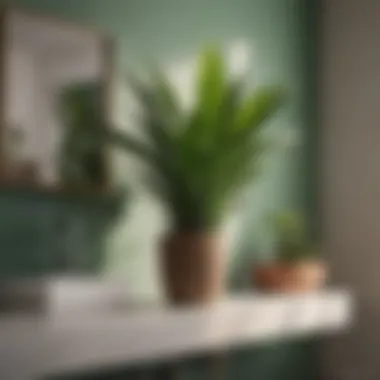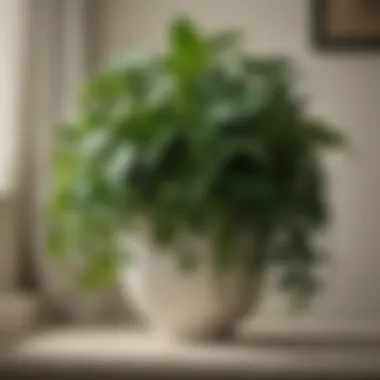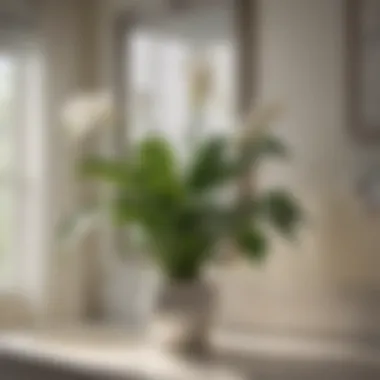Top Low-Light Plants Perfect for Bathrooms


Intro
In spaces deprived of natural light, especially bathrooms, the challenge of choosing the right plants can be daunting. Nonetheless, greenery can enhance mood and aesthetics, offering a touch of life to otherwise sterile environments. In this article, we delve into plant choices that not only survive but thrive in low light. For homeowners and design enthusiasts alike, the experience of incorporating these elements is rewarding and practical.
Maintaining a calm and inviting atmosphere in one’s home is essential. Plants are more than decorations; they contribute to air quality, create a soothing ambiance, and can foster a sense of well-being. The unique conditions of bathrooms present specific needs for plant care. Here, we will offer insights into ideal plant species, their care requirements, and methods to integrate them seamlessly into your bathroom environment, even when light is scarce.
Design Inspirations
Incorporating plants into a bathroom design doesn't merely satisfy a desire for aesthetics; it significantly elevates the overall space. When considering plants for a bathroom without natural light, it is essential to recognize inspiring design elements.
Trending Styles
Among the popular styles for bathrooms today are minimalistic and modern designs. These styles call for clean lines, subtle elegance, and functional decor. Grouping low-light plants like Spathiphyllum or Snake Plant within chic planters can enhance this modern feel. Their shapes and textures add dimension against otherwise flat surfaces, creating an appealing contrast.
Mixing plant types allows for diversity while maintaining coherence in design. Smaller pots perched on shelves can draw the eye upward, while larger plants can provide a grounding effect when displayed on the floor.
Color Palettes
Choosing the right colors for your bathroom can bolster the impact of the selected plants. Soft pastels or neutral tones serve as an excellent backdrop that highlights greenery. For instance, a Pothos can flourish vibrantly against a pale blue or muted gray wall. The subtle interplay of colors heightens the sense of calm.
Additionally, consider the textures in your space. Smooth ceramic plant pots paired with textured fabrics or wooden shelves introduce tactile variety. A thoughtful color palette not only makes the plants pop but also ties the entire room together.
"In a world of chaos, your home should be your retreat, filled with peace and beauty."
Choosing the Plants
When selecting plants for bathrooms lacking sunlight, several species stand out for their hardiness and low-light adaptability. The key is to seek varieties that require minimal maintenance. Here are some excellent choices:
- Spathiphyllum (Peace Lily): Known for its ability to survive in very low light conditions, it produces lovely white flowers and helps purify the air.
- Zamioculcas zamiifolia (ZZ Plant): This plant is nearly indestructible and thrives in low light. Its glossy leaves resemble a more tropical feel.
- Sansevieria (Snake Plant): This resilient species is often hailed as an ideal choice for low light; it can tolerate neglect yet consistently looks attractive.
- Pothos: Its trailing vines can drape beautifully from shelves or hangers, adding a dynamic element to the space.
- Philodendron: Available in many varieties, it’s adaptable and requires very little sunlight.
Practical Care Tips
Caring for low-light plants involves understanding their particular needs.
- Watering: Be conservative with watering. Overwatering is a common mistake. Ensure pots have drainage holes to prevent root rot.
- Humidity: Bathrooms often have inherent moisture; most low-light plants appreciate this. However, they may still benefit from occasional misting.
- Fertilization: Low-light plants require less fertilizer compared to those thriving in bright light. A diluted, balanced fertilizer every few months usually suffices.
- Cleaning: Dust can accumulate on leaves, blocking light absorption. It’s good practice to wipe them clean periodically.
Intro to Low-Light Plants
In today's urban settings, many homes lack sufficient natural light, particularly in spaces such as bathrooms. This creates a need for indoor plants that can thrive in low-light conditions. Understanding which plants can adapt is essential for creating a welcoming and relaxing environment. Indoor plants not only enhance the aesthetic appeal of these spaces but also contribute significantly to our well-being.
Choosing the right plants for low-light areas, such as bathrooms, is important. They can help create a serene atmosphere that promotes tranquility and calmness. Furthermore, adding greenery can be a simple yet effective way to improve air quality and introduce a touch of nature into our daily lives.


Understanding the Need for Indoor Plants
Indoor plants are not merely decorative; they offer various health benefits that are essential for well-being. For households, especially those with children and pets, incorporating plants can improve air quality by filtering toxins and reducing harmful pollutants. Furthermore, indoor plants can help regulate humidity levels, which is a unique challenge in bathrooms.
Research indicates that having plants indoors can lead to improved mood and reduced stress levels. Engaging with plants—even through watering or pruning—can foster a sense of responsibility and connection to the environment.
Moreover, plants have been shown to enhance concentration and productivity, which is beneficial for those who work from home. When placed in bathrooms, plants can elevate the space and contribute to a soothing environment conducive to relaxation.
The Challenges of Bathrooms Without Natural Light
Bathrooms without natural light pose specific challenges when it comes to plant care. The lack of direct sunlight can hinder growth and development of many common houseplants. Besides, high humidity levels tend to be present in these spaces due to frequent bathing and showering. This creates a microclimate that not all plants can tolerate.
Light deprivation can lead to stunted growth or even death in plants that are not suited for these conditions. Therefore, when selecting plants for such environments, consideration must be given to species that not only tolerate low light but also thrive in high humidity.
Benefits of Using Plants in Bathrooms
Incorporating plants into bathrooms can yield various advantages, especially in spaces lacking natural light. This section elaborates on the significance of using plants in bathrooms, highlighting three primary benefits: air purification, aesthetic enhancement, and stress reduction. Each benefit contributes not only to the overall ambiance but also to the health and well-being of the occupants.
Air Purification Properties
Plants have an inherent ability to improve indoor air quality. They absorb harmful pollutants and release oxygen, making the environment healthier. In bathrooms, which often contain moisture and cleaning chemicals, certain low-light plants can serve as natural air purifiers. The Peace Lily and Snake Plant are known for their capacity to filter toxins like formaldehyde and benzene. Their presence not only helps in reducing airborne toxins but also harmonizes the indoor climate, promoting a fresher atmosphere.
Aesthetic Enhancement
The visual appeal of plants in bathrooms cannot be understated. Greenery adds life and vibrancy to otherwise sterile spaces. In low-light environments, carefully chosen plants provide a touch of color and texture, breaking the monotony. For example, Boston Ferns or Pothos can create a lush, inviting feel. Furthermore, the aesthetic enhancement of the space positively impacts the mood of occupants, making bathrooms feel more like personal retreats. The strategic placement of plants can influence the perception of space, making it appear more expansive and welcoming.
Stress Reduction and Well-Being
Plants are linked to improved mental health and reduced stress levels. Studies suggest that having greenery around can promote relaxation and enhance overall well-being. Being in an environment with plants can lower anxiety and improve mood, making the bathroom not just a functional space, but a calming sanctuary. Bathrooms with plants encourage mindfulness and self-care routines. By integrating plants into daily life, individuals cultivate a sense of connection with nature, even when sunlight is scarce.
"Integrating plants into your bathroom can transform it from a utilitarian space into a serene haven."
In summary, the incorporation of plants in bathrooms lacking natural light is more than an aesthetic choice. It brings tangible benefits, from purifying air to reducing stress, enhancing both the functionality and ambiance of these essential spaces.
Selection of Suitable Plants for Low-Light Bathrooms
Choosing the right plants for a bathroom without natural light is essential. It can transform this often overlooked space into a vibrant area. Suitable plants not only enhance appearance but also improve air quality and create a calming environment. Moreover, the selection process requires understanding the light levels, humidity, and temperature fluctuations typical in bathrooms. Most importantly, these conditions influence how well a plant will thrive.
Sansevieria (Snake Plant)
Sansevieria, commonly known as Snake Plant, is an excellent option for low-light bathrooms. This plant is hardy and can survive in indirect light. It has long, upright leaves with striking patterns, creating an attractive element in the room. Its reputation extends beyond aesthetics; it also purifies air by removing toxins. Snake Plant is forgiving about watering as well, requiring neglect rather than daily watering.


Zamioculcas zamiifolia (ZZ Plant)
ZZ Plant is another favorite for those lacking in natural light. It features glossy, dark green leaves that reflect a little light, making it visually appealing. This plant is known for its drought resistance, as it stores water in its thick rhizomes. It thrives on infrequent watering and minimal care, making it an ideal choice if you have a busy lifestyle. It can handle low light well, which means it fits perfectly in a bathroom environment.
Aspidistra (Cast Iron Plant)
Known for its strength, the Aspidistra, or Cast Iron Plant, lives up to its name. This plant can withstand neglect, poor lighting, and fluctuating temperatures. Its broad, dark green leaves can add a touch of greenery to a bathroom. It requires very little maintenance and can tolerate a range of conditions. Regular watering is not necessary; it prefers to dry out between waterings.
Ferns (e.g., Boston Fern)
Ferns, such as Boston Fern, add a lush and soft aesthetic to spaces. They thrive in humid environments, perfect for bathrooms. Despite being sensitive to light, they adapt to low-light conditions quite well. However, they do require consistent moisture, so a little more attention in terms of care is needed. Their fine foliage can drape beautifully from shelves or hangers.
Pothos (Epipremnum aureum)
Pothos is a versatile and resilient plant that does well in lower light conditions. Its trailing vines can grow long, making it a great candidate for hanging displays or shelves. The heart-shaped leaves are typically variegated, adding visual interest. Pothos is also forgiving in watering, allowing the soil to dry out before the next watering. It additionally acts as an air purifier, making it not only a beautiful choice but a functional one.
Peace Lily (Spathiphyllum)
The Peace Lily is valued for its elegant white blooms and beautiful dark green leaves. This plant can thrive in low light while preferring higher humidity, thus making it suitable for a bathroom. It signals when it needs water by drooping slightly, which is helpful for caretakers. Peace Lily effectively filters out harmful chemicals, contributing to cleaner indoor air quality.
Choosing the right plants for your low-light bathroom can significantly improve its ambiance and functionality.
In summary, the selection of these plants involves weighing their care needs against your bathroom's conditions. Each plant offers unique benefits, from aesthetic enhancements to air purification. As you choose your plants, consider how their characteristics align with your lifestyle and the overall atmosphere you want to create.
Care Guidelines for Low-Light Plants
When it comes to cultivating plants in bathrooms without natural light, understanding the care guidelines is crucial. These guidelines not only ensure the health and longevity of the plants but also facilitate a more harmonious environment in your personal space. Because such bathrooms present unique challenges, careful attention to specific elements will yield the best results.
Watering Practices
Watering is the most critical aspect of plant care. In low-light conditions, plants usually need less frequent watering compared to those in brighter environments. Overwatering is a common issue that leads to root rot. It is essential to check the moisture level in the soil before watering. Stick your finger about an inch into the soil; if it feels dry, it is time to water. Most low-light plants prefer to dry out slightly between waterings.
Soil and Potting Requirements
Selecting the right soil mixtures is another key factor. Most low-light plants thrive in well-draining soil. A standard potting mix often suffices, but adding perlite or sand can improve aeration. As for potting, choose containers with drainage holes to prevent water from sitting at the bottom. Being mindful of these requirements significantly affects the growth and vitality of your indoor plants.
Fertilization Recommendations
Fertilizing low-light plants can be complex due to their lower growth rates. A balanced, water-soluble fertilizer can be used during the growing season, typically spring and summer. However, it is wise to reduce the frequency of fertilization in the fall and winter, as most plants slow their growth during these times. Always follow the manufacturer's instructions for dilution rates, as over-fertilizing can harm plants.
Humidity Considerations


Bathrooms often have higher humidity levels due to showers and baths. While this can be beneficial, different plants have different humidity needs. Monitor the conditions and adjust as necessary, using a humidity tray or a small room humidifier if needed. Plants like peace lilies thrive in high humidity, while others may prefer drier conditions. Regularly assess the bathroom's atmosphere to maintain optimal growth conditions.
By providing proper care, your low-light plants can flourish, adding beauty and serenity to your bathroom space.
In summary, understanding these care guidelines is essential for the health of your plants. With the right watering habits, suitable soil, careful fertilization, and humidity management, you can create an inviting environment in your bathroom, even in the absence of natural light.
Designing a Plant-Friendly Bathroom
Creating a plant-friendly bathroom goes beyond simply placing greenery in the space. It involves strategic planning to ensure that plants thrive and contribute positively to the environment. A well-designed setup can amplify the aesthetic of the bathroom while promoting the health of the plants. By understanding how to utilize space creatively, homeowners can enhance their personal retreat, making it both functional and serene. Proper design also considers factors such as humidity, light conditions, and accessibility for plant care.
Choosing the Right Location
Location is key when it comes to placing plants in a low-light bathroom. Every corner of the bathroom can have different levels of humidity and light. Plants generally thrive in areas where they can receive indirect light or are situated near sources of moisture. For instance, areas around the bathtub or sink can have higher humidity, benefiting plants such as ferns and peace lilies. Analyzing your space is essential; decide whether to place pots in niches, on countertops, or hanging near windows, if any exist. This approach ensures plants receive adequate moisture without becoming overly damp, which could lead to root rot.
Creative Display Options
Vertical Gardens
Vertical gardens represent a unique solution for maximizing space in smaller bathrooms. They provide a lush look without occupying precious floor space. This type of installation can transform an entire wall into a green oasis, which is particularly inviting in a low-light scenario. Vertical gardens can utilize wall-mounted planters or pockets, allowing plants to cascade beautifully down the surface. However, maintaining adequate care can be a challenge, as soil may dry out more quickly in a vertical format. It's important to select hardy plants that can withstand fluctuating moisture.
Hangings and Shelves
Hanging planters and shelves offer exciting visual dimensions. Elevating plants can create an eye-catching display while keeping plants away from bathroom traffic. This option works well for trailing plants like pothos or spider plants. Shelving can also support a variety of pots without cluttering surfaces. This flexibility allows for unique arrangements tailored to personal style. However, care must be taken to manage light conditions; placed too high, some plants may not thrive if not given enough indirect light over time.
Countertop Displays
Countertop displays can enhance the look of the bathroom without complicated arrangements. Having a plant on the counter provides easy access for care, ensuring regular watering and maintenance. This method works well with small pot sizes or unique containers that complement bathroom decor. It’s a straightforward solution but requires choosing plants that are suited to the limited light. While it is a simple approach, one should remain vigilant to prevent pots from becoming overcrowded with supplies or toiletries.
End
In this article, we have delved into the relevance of incorporating plants into bathrooms characterized by low or no natural light. The importance of this topic lies not only in enhancing the aesthetic appeal of these spaces but also in promoting a healthier living environment. It can be challenging for homeowners to maintain a lively atmosphere in bathrooms deprived of sunlight. However, choosing the right plants can bring vibrant greenery into these often-overlooked areas.
Summarizing the Benefits of Plants in Low-Light Conditions
Integrating plants into low-light bathrooms offers numerous advantages. First, certain plants have air purification properties that help to improve indoor air quality. This benefit is especially crucial in bathrooms, where humidity levels can be high, potentially fostering mold and mildew growth. Plants such as the Snake Plant and Peace Lily filter toxins and enhance the overall freshness of the air.
Second, the aesthetic enhancement that plants provide cannot be overstated. Greenery adds color and life to the often sterile confines of a bathroom. A well-placed Pothos or Boston Fern can transform the space, making it feel more inviting and tranquil.
Finally, having plants in the bathroom contributes to stress reduction. Studies suggest that interacting with greenery can lower cortisol levels and lead to improved well-being. Rooms that include plants are often perceived as more relaxing and calming, making them perfect for personal retreats after a long day.
Encouragement to Explore Personalization
Personalizing your bathroom with plants is an opportunity for self-expression. Consider your personal style and how different plants fit within that vision. Whether you prefer the structured leaves of a ZZ Plant or the soft textures of ferns, the variety allows one to reflect their personality.
Moreover, engaging in plant care can be therapeutic, adding to the connection with one's living space. Personalization can extend beyond plant choice to include creative display options, such as hanging pots or vertical gardens.
Ultimately, the journey of selecting and caring for plants should align with your individual tastes and lifestyle. By embracing this process, you can create a serene bathroom atmosphere that resonates with your unique identity. Embrace the opportunity to create a welcoming space that is not only functional but also rich in character.



